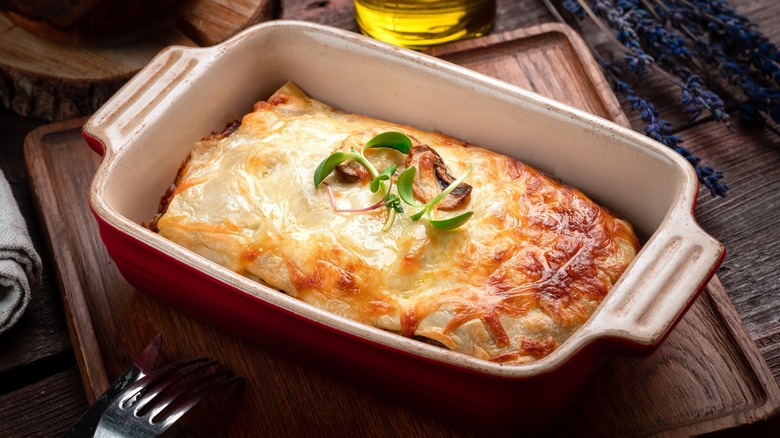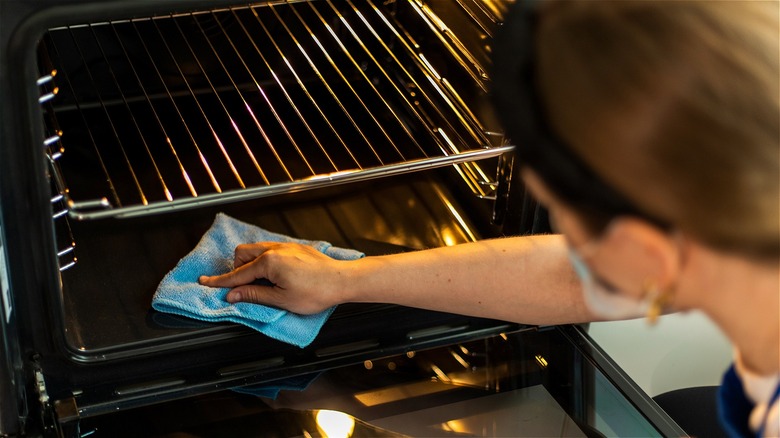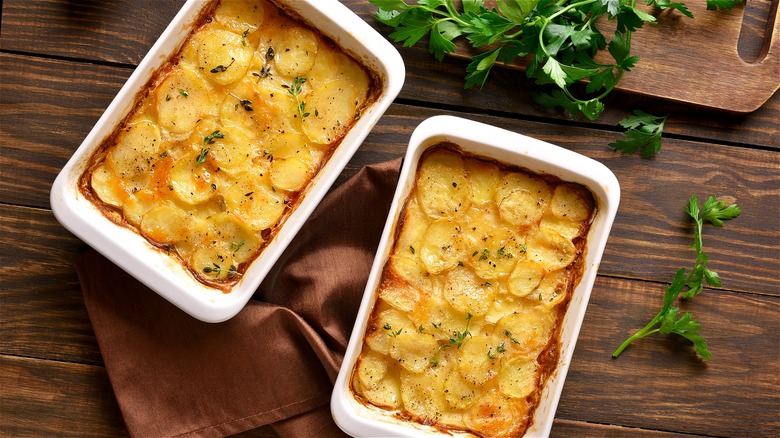Overfilling Your Casserole Dish Is A Recipe For Disaster
Whether you enjoy making an easy breakfast egg casserole or a vegetable tortellini casserole, there's no easier path to a hearty dinner than stuffing a casserole dish and sticking it in the oven. Even better is that leftover casserole can be just as delicious, but if you're thinking of stuffing your bakeware to the top so you can feast for days, think again. Filling your dish to maximum capacity is one of the biggest casserole mistakes you might make.
The most obvious drawback is the overflow factor — a super full casserole dish may not only take longer to cook, but could also spill all over the racks and bottom of your oven. Even if you somehow get your overstuffed casserole to cook through evenly in a reasonable timeframe, disaster can strike when it's time to serve it. Using a spoon or knife to lift the food out of the dish without any extra spilling over the sides is nearly impossible. Whether you're working with a deeper or more shallow casserole dish, you should only be filling it to ¾ full, max.
The material of the dish doesn't have a bearing on this, either — whether it's glass, cast iron, or ceramic, no material is necessarily better at handling too much food at once. If you're still feeling tempted, you should know why a casserole can easily overflow, and how an overfilled dish can make your recipe far less convenient.
Overfilled casseroles can be bad news for baking and cleaning
An overfilled casserole can take additional time to cook, as the ingredients won't have an even exposure to heat that helps them cook through properly. You could end up with burnt edges and an undercooked center. Making an oversized casserole is tempting if you're feeding a crowd, but everyone will have to sit and twiddle their thumbs while you're busy opening and closing the oven door over and over, checking if the dish is finally done.
Additionally, many foods expand in volume once cooked, especially pasta, rice, and grains — three popular ingredients in savory casseroles. Even if you fill your dish to the top with no spillover, the food needs extra space to rise up, and if there is none, overflow is almost guaranteed. Casseroles that contain thinner sauces or extra toppings are also especially prone to bubbling over. The spills can stick to the bottom of your oven and prove very difficult to remove, even with extra scrubbing. Spillover may also leave dried residue on the exterior of your baking dish, which can be equally hard to get rid of.
Conversely, it's also possible to underfill a casserole dish. Baking a shallow casserole doesn't present as many pitfalls an overfilled one, but they can easily overcook and end up dry. To keep casseroles as easy and convenient as they should be, fill your baking dish about ¾ of the way.
Mindful prep ensures easier casseroles
If you really need a few extra helpings of casserole, just double your recipe and bake it in two dishes. Yes, you will have to clean an extra dish, but that will be a cakewalk compared to cleaning the entire inside of your oven. Aside from properly filling your baking dish, you can follow a few other tips to pull of easy casserole recipes for breakfast, dinner, and everything in between. For instance, if your dishes often end up with burnt-on residue, or you're baking a delicate recipe like an extra-large frittata, line your casserole dish with parchment paper before pouring in your ingredients. Cleanup will be a snap, and your casserole can be served and sliced in perfectly intact pieces.
Try as you might, it's possible to accidentally overfill your casserole dish, especially if you use one with dimensions that are different than what the recipe calls for. To protect your oven, place your dish on a baking sheet to catch any residual spills or drips. Alternatively, you can place a baking sheet or a long, flat piece of aluminum foil along the lower rack of your oven to catch any potential splatters.
Once your casserole comes out of the oven, give your meal proper time to rest. It can be hard to be patient, but just 15 minutes allows all the ingredients, including the saucier components, to properly meld together for cleaner slices and an easier casserole-eating experience.


